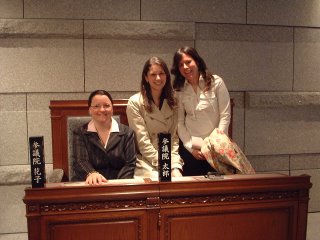National Diet
Here is a little history on the Japanese Diet if you would like to know more about it. Otherwise, you can just look at my pictures!
Japan's first modern legislature was the Imperial Diet (帝國議会; Teikoku Gikai) established by the Meiji constitution in force from 1889-1947. The Meiji Constitution was adopted on February 11, 1889 and the Imperial Diet first met on November 29, 1890 when the document entered into operation. The Diet consisted of a House of Representatives and a House of Peers (貴族院; Kizokuin). The House of Representatives was directly elected, if on a limited franchise; universal adult male suffrage was introduced in 1925. The House of Peers, much like the British House of Lords, consisted of high ranking nobles.
The word diet derives from Latin and was a common name for an assembly in Medieval Germany. The Meiji constitution was largely based on the form of constitutional monarchy found in nineteenth century Prussia and the new Diet was modelled partly on the German Reichstag and partly on the British Westminster system. Unlike Japan's modern constitution, the Meiji constitution granted a real political role to the Emperor, although in practice the Emperor's powers were largely directed by a group of oligarchs called the genro.
To become law a bill or constitutional amendment had to have the assent of both the Diet and the Emperor. This meant that while the Emperor could no longer legislate by decree he still had a veto over the Diet. The Emperor also had complete freedom in choosing the Prime Minister and the Cabinet, and so, under the Meiji constitution, Prime Ministers often were not chosen from and did not enjoy the confidence of the Diet. The Imperial Diet was also limited in its control over the budget. While the Diet could veto the annual budget, if no budget was approved the budget of the previous year continued in force.
The postwar Constitution of Japan, adopted in 1947, created a more democratic system and renamed the legislature to the National Diet. Under the document the franchise was extended to women for the first time and the House of Peers was abolished and replaced with the directly elected House of Councillors. The Emperor was reduced to his current, purely ceremonial role, and the Diet declared the "highest organ of the state power" (Article 41). All Diet elections occurred under the Single Non-Transferable Vote system.
The proportional representation system for the House of Councillors, introduced in 1982, was the first major electoral reform under the postwar constitution. Instead of choosing national constituency candidates as individuals, as had previously been the case, voters cast ballots for parties. Individual councillors, listed officially by the parties before the election, are selected on the basis of the parties' proportions of the total national constituency vote. The system was introduced to reduce the excessive money spent by candidates for the national constituencies. Critics charged, however, that this new system benefited the two largest parties, the LDP and the Japan Socialist Party, which in fact had sponsored the reform.

In front of the Diet Building after the tour.

It was slightly overcast that day, so the pictures are a little dark.


Here is a portion of a typical bench where the councillors sit when they are in session.

In the 1950's, there was a terrific lightening storm that struck the Diet building. Some lucky photographer caught it on film!

They had a museum of political artifacts. This represents a party.

A statue inside the gates.

The Parliament. They were in the process of steam-cleaning the carpets.

In Japan, they "wrap" trees. More on this later.

An old voting system.

0 Comments:
Post a Comment
<< Home